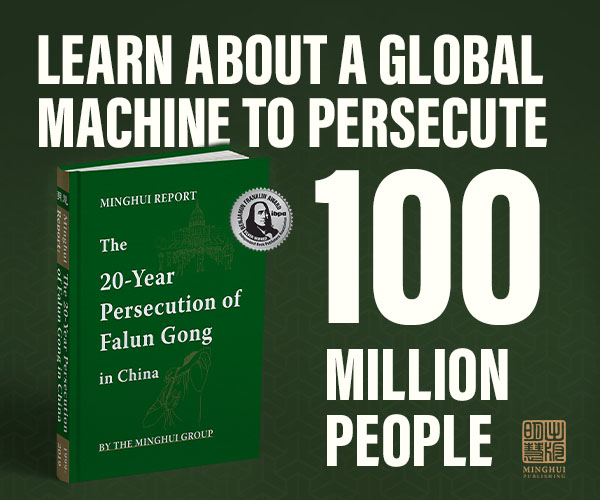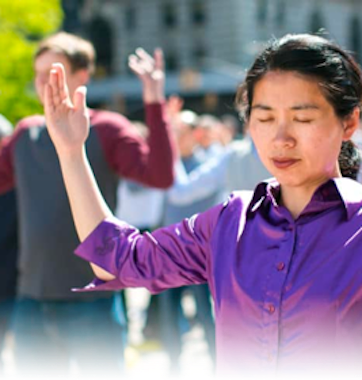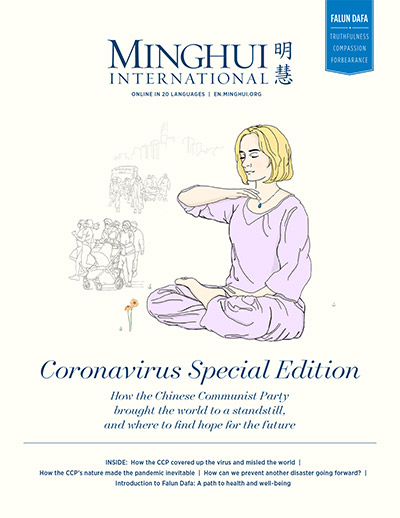(Minghui.org) In Istanbul’s poor neighborhood lived a man who was born blind in both eyes. With a hobby of painting, however, he was able to paint houses, mountains, lakes, faces, and mountains. Not only that, he could accurately depict color, shadow, and perspective. All these puzzled scientists. “My breath was taken away,” exclaimed John Kennedy, a psychologist at the University of Toronto, when he witnessed it.
This blind man is Esref Armagan and his story was reported by New Scientist on January 26, 2005, in an article titled “ Senses special: The art of seeing without sight.” One of his eyes did not develop beyond a rudimentary bud, and the other one was stunted and scarred, making his brain unable to detect light. But he began painting with his fingers at 18 and improved his skills over time.
In one experiment, Kennedy and other psychologists asked Armagan, then 51, to draw a cube, and then rotate it to the left, and then further to the left – a challenging task even for a person who is able to see. “Armagan drew a scene with all three cubes. Astonishingly, he drew it in three-point perspective – showing a perfect grasp of how horizontal and vertical lines converge at imaginary points in the distance,” wrote the article. This really shocked Kennedy and other scientists.
Amir Amedi, a neurologist from Harvard, found that Armagan's visual cortex lit up during the drawing task, but not for the verbal recall. In addition, his visual cortex was only mildly activated when he imagined items he had touched. All these showed he functioned just like a sighted person, except his eyes could not see.
“We normally think of seeing as the taking in of objective reality through our eyes. But is it?” wrote the New Scientist article.
The Third Eye
Evidence from other sources also showed one could see things beyond the eyes. Since September 1979, the Chinese journal Ziran Zazhi (Nature Magazine) published numerous articles about children in various parts of China who were able to recognize written symbols and printed pictures placed in black plastic tins with close-fitting lids.
These phenomena are often related to the pineal body in the brain, which connects the junction of the eyebrows in the forehead. Because the pineal body is related to light perception, modern anatomists consider it is a vestigial remnant of an evolutionarily atrophied organ or the third eye. From experiments, researchers have now found that, in the absence of a functional cornea, a mouse can still sense light leading to activation of the pineal gland.
Such a notion went back to Greek physician and philosopher Galen, who believed the pineal body was related to one’s soul. French philosopher, mathematician, and scientist René Descartes went further. In contrast to animals, “Descartes concluded that a God-given soul endows humans with intelligence and awareness, and he designated the pineal gland as the interface between the body and soul, the ‘seat of rational thought’,” wrote a 2022 BMJ journal titled “Pineal gland as the source of the soul and third eye”.
Ancient Wisdom
In traditional Buddhism and Taoism, the pineal body was often referred to as a celestial eye, one that can see beyond this physical dimension. Among the four diagnostic ways of traditional Chinese medicine – look, listen, question, and feel the pulse – the look was placed first. In fact, some physicians in ancient times had supernormal abilities and by taking a look at a patient, they could see the patient’s skin, muscles, internal organs, and even bone marrow. Therefore, they could see the root cause of the illness instantly.
According to Shiji (Historical Records), one of the most respected history books in China, Bian Que was able to see through a patient’s body and tell what was wrong. On one occasion, he met the king of Qi Kingdom and pointed out the onset of his illness. In subsequent visits, he indicated the progress of the illness step by step. But the king did not listen and died in the end as Bian predicted.
Ancient sage Laozi (also known as Lao Tzu) also described enlightenment through cultivation practice, “Without opening your door, you can know the whole world. Without looking out your window, you can understand the way of the Tao.” In addition, Yang Jian in Chinese legends was said to have a third eye. In many Buddha statues and paintings, there is a third eye between the eyebrows. Shakyamuni mentioned in one grain of sand, that there are three thousand worlds, based on views from the third eye.
Similar findings were also seen in archaeological discoveries. Hongshan Culture from 5,000 years ago in today’s Inner Mongolia had portraits with a third eye between the eyebrows. Other ancient civilizations, such as those in Sumer and India, also have records related to the third eye or pineal body.
Plato believed a person’s soul was not only responsible for basic needs (such as eating) and emotions (such as sensory functions), but also rationality. He considered the soul immortal and stated that the body was its temporary “prison” or “grave,” because the soul would be released upon death. For him, the pineal body is better than 10,000 regular eyes because it can help a person see the truth.
Limitation of Regular Eyes
Some people refuse the idea of a third eye and only accept those perceived by regular eyes. But the world we live in is beyond what our eyes can see. For example, we can see light with a wavelength between 380 to 700 manometers, which is only a tiny fraction of the electromagnetic spectrum.
Modern physicists found only 4% of the universe is composed of everything we can see with our eyes and telescopes, ranging from all intergalactic and interstellar gas and dust to stars, planets, and life. The remaining things are dark energy and dark matter. If we bluntly deny things that we cannot see, it would not be any different than the Indian parable in which a blind man failed to know what an elephant looks like by only touching a leg or tusk.
Many great scientists have realized this. “The important thing is not to stop questioning. Curiosity has its own reason for existence,” remarked Albert Einstein, “One cannot help but be in awe when he contemplates the mysteries of eternity, of life, of the marvelous structure of reality. It is enough if one tries merely to comprehend a little of this mystery each day.”
There are lots of such examples. From the universe to life, to religions to supernormal abilities, from prehistorical civilization to other dimensions, mankind’s wisdom is very limited. The meridian system, for example, was not found in classical anatomy. But it was confirmed by modern science with the help of computers. Li Shizhen, a great physician in the Ming Dynasty, was already clear on that. “To observe the internal organs and meridian channels, only those with supernormal abilities could do that,” he wrote.
The Divine
While some scientists only accept things that are proven true by empirical science, Einstein is more open-minded. “I like to think that the moon is there even if I am not looking at it,” he said. Regarding spirituality, he added, “I want to know God’s thoughts; the rest are details.”
This is consistent with the religious world. In both Buddhism and Christianity, those with a strong faith in being good could sometimes see miracles. Similarly, near-death experiences (NDEs) also show the existence of souls. Often underreported, “They share broad commonalities—becoming pain-free, seeing a bright light at the end of a tunnel and other visual phenomena, detaching from one’s body and floating above it, or even flying off into space (out-of-body experiences),” wrote a June 2020 Scientific American article titled “What Near-Death Experiences Reveal about the Brain.”
The third eye is often related to one’s moral levels. In the Gendaya civilization, the first civilization according to Mayan culture, men had a third eye in the middle of their foreheads, but this disappeared in later civilizations.
The same happens with children. As mentioned above, some children are able to see things beyond their regular eyes at a young age. After they are more influenced by modern society with selfishness and other notions their supernormal abilities often diminished over time.
Falun Dafa Enlightens Its Practitioners
There are ways to slow down or reverse the degeneration associated with moral decline. One example is Falun Dafa. Also known as Falun Gong, it is a meditation system based on the principles of Truthfulness-Compassion-Forbearance. As practitioners apply these teachings in their daily life, they are able to achieve better health, higher moral values, and enlightenment.
When reading Falun Dafa books and doing the exercises, some practitioners have seen scenes in other dimensions such as those related to divinity. They include rotating Falun (law wheel), Buddha, fairies, and more. Some audience members also saw similar scenes like fairies and paradises when watching Shen Yun's performances.
Falun Dafa also brings enlightenment to practitioners and bestows them with wisdom. An article on May 30 this year from Minghui told the story of a girl who survived her mother’s abortion while a 29-week-old fetus. Despite her unusual experience, this young girl was taken good care of by the author and her mother, both Falun Dafa practitioners. The girl grew up healthy and blessed with kindness, smartness, and a pure heart, all thanks to her practice of Falun Dafa.
Another example concerns a woman in her 50s. She struggled with social interactions and felt extremely uncomfortable when in the spotlight. She would even shake when she had to speak in front of a crowd. Her social skills, however, improved dramatically after she began practicing Falun Dafa. With a sincere heart to spread the goodness of the practice, she began approaching people and talking to them about Falun Dafa. Before she knew it, she no longer felt awkward in social situations, and her work performance also got better. Her supervisor praised her more than once at meetings. When her company held a speech competition, she presented a prose she wrote herself. The audience was so captivated by her performance that one person shouted, “Give her a special award!” She said that would have been impossible had she not practiced Falun Dafa.
A third example is about a 50-year-old woman who began practicing Falun Dafa in 1996 when she was in her 20s. After the persecution began in 1999, she left China to pursue her graduate degree in a different country. While many other students had to study long hours, oftentimes late into the night, she said she was able to study less time but achieve better results. She credits Falun Dafa for giving her wisdom to become more efficient and better at time management.
There are numerous examples like these where Falun Dafa practitioners have become better and more productive citizens of society by following the principles of Truthfulness-Compassion-Forbearance.
Finding Our Path
Prophets including Nostradamus predicted the catastrophe in 1999. But Jeane Dixon, one of the best-known American astrologers, claimed the danger no longer existed due to “The Child of the East” who had grown up. “The world as we know it will be reshaped and revamped into one without wars or suffering,” she said upon her death in 1997, “he will bring together all mankind in one all-embracing faith.”
Given all the chaos in the world, we are also living in a special era of opportunities. Following our heart and conscience, we may be able to find the blessings and wisdom that mankind has been waiting for.
Views expressed in this article represent the author's own opinions or understandings. All content published on this website are copyrighted by Minghui.org. Minghui will produce compilations of its online content regularly and on special occasions.










